Already a sign of Autumn in the Air in Belgium (No.28)
The maximum temperature in Brussels yesterday fell below 20˚C at last and the minimum temperature was 10˚C. The leaves of the trees in the forest on the outskirts change colour and if it were in Tokyo, this looks completely like autumn. According to the Belgians, this summer seems to have been abnormal because of the continued sunny weather, especially in July. Although I worked in Belgium 36-37 years ago, I do not recall that the summers were so pleasant. No need to go on vacation to Southern France or the Mediterranean with splendid weather like this. Thinking about the unusually bad weather last winter, the beautiful weather seems almost unreal. Brussels, in terms of latitude, is situated nearly on the same latitude as Sakhalin island in the Far East. Therefore, in July, the sun rises around half past five in the morning and the sun sets after 10 o’clock at night. However, once entered the second half of August, the days become shorter all of a sudden. The sun does not come up before seven in the morning and goes down around half past eight. In one month and a half’s time, the daylight hours become more than three hours shorter. In the middle of winter, the sun rises at nine in the morning and sets at half past four in the afternoon, which means that two thirds of the day is night. The sign of autumn in the air makes me feel melancholic already.
< Diplomatic Exchange between Japan and Belgium >
There are no specific diplomatic issues between Japan and Belgium, so in that sense the relationship is good, but we cannot say that the interaction at the political level is very active. In this context, Mr. Masaji Matsuyama, Parliamentary Senior Vice-Minister for Foreign Affairs (Member of the House of Councillors) visited Brussels where he had a meeting with Mr. Didier Reynders, Minister of Foreign Affairs (Deputy Prime Minister), which has been a good opportunity to deepen the collaboration between both governments. The two had a thorough conversation on how to develop economic relations between both countries and also exchanged views on the international situation from East Asia to Africa and the Middle East. Further, Mr. Matsuyama met with Mr. Armand De Decker, Vice President of the Senate (Minister of State) as well, who showed him around in the Senate. They had a meaningful exchange of opinions about parliamentary exchange and other subjects. Mr. De Decker paid an official visit to Japan 14 years ago as the President of the Senate. He told us that he kept very good memories of the audience that was granted with his Majesty the Emperor on that occasion. Furthermore, Mr. Matsuyama talked with representatives of Japanese companies active in Belgium and was briefed about the current state of business in Belgium. By the way, Ms Toshiko Abe, Parliamentary Secretary for Foreign Affairs and Member of the House of Representatives, visited Brussels 10 days ago and next week members of the Surveillance Committee on Finances and Administration of the House of Representatives will visit Belgium to exchange opinions with officials of the Belgian Federal Parliament. As an Ambassador I am very glad that such interaction at a political level and between members of Parliament proceeds.
< A Visit of Belgian High School Students to Japan >
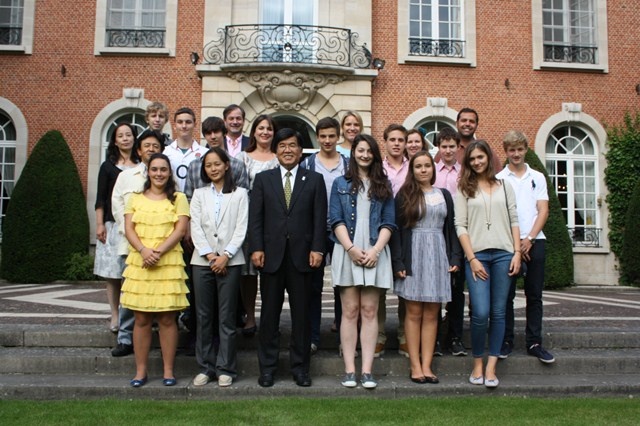 Three days ago, I invited about 20 students and teachers of the International School of Brussels (ISB) to my residence. Last year ISB invited about 30 high school students from Miyagi Prefecture in Japan to Belgium as part of the support programmes for the victims of the Great East Japan Earthquake. This year, 16 ISB students visited Japan for about 3 weeks from end of July to August and deepened exchanges. This time, I invited these students, the teachers that accompanied them and the people that were instrumental in the realization of this exchange. I asked them about their interaction with the high school students in the disaster areas and about their impression of the places they visited such as Kesennuma in Tohoku. As a Grand Sumo Wrestling Tournament was held in Nagoya just when they visited, they told nostalgically that they met with the Sumo Champion (Yokozuna in Japanese) Hakuho. Their two-day stay at the Ninna Temple in Kyoto also seems to be a good memory. However, the days spent with their host families at Kesennuma left the strongest impression, as well as the coast line with the remnants of the damage caused by the tsunami. When I asked them if they would like to go to Japan again next year, I was very glad that almost all said yes. Three days ago, I invited about 20 students and teachers of the International School of Brussels (ISB) to my residence. Last year ISB invited about 30 high school students from Miyagi Prefecture in Japan to Belgium as part of the support programmes for the victims of the Great East Japan Earthquake. This year, 16 ISB students visited Japan for about 3 weeks from end of July to August and deepened exchanges. This time, I invited these students, the teachers that accompanied them and the people that were instrumental in the realization of this exchange. I asked them about their interaction with the high school students in the disaster areas and about their impression of the places they visited such as Kesennuma in Tohoku. As a Grand Sumo Wrestling Tournament was held in Nagoya just when they visited, they told nostalgically that they met with the Sumo Champion (Yokozuna in Japanese) Hakuho. Their two-day stay at the Ninna Temple in Kyoto also seems to be a good memory. However, the days spent with their host families at Kesennuma left the strongest impression, as well as the coast line with the remnants of the damage caused by the tsunami. When I asked them if they would like to go to Japan again next year, I was very glad that almost all said yes.
< The Belgian Nuclear Research Centre and Fukushima University >
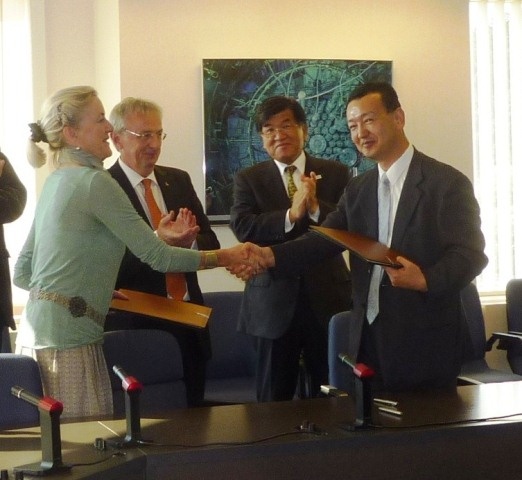 Last week, in Brussels, a signing ceremony of a Memorandum of Understanding (MOU) on research cooperation between the Belgian Nuclear Energy Research Centre (SCK・CEN) and Fukushima University took place. After the accident at the Fukushima Daiichi nuclear power plant in March 2011, SCK・CEN proposed to jointly study the impact of this accident on the ecosystem. This time, on the occasion of Prof. Dr. Takayuki Takahashi’s, Vice Rector of Fukushima University, visit to Belgium, the cooperation memorandum was signed. Originally, SCK・CEN promoted cooperation projects on radioecology called COMET involving all Europe. In practice, it is likely that Fukushima University will participate in these projects. Also, as already mentioned in Ambassador’s Chat No. 17, SCK・CEN promotes advanced research on the management of radioactive waste and therefore advanced cooperation with Fukushima University is expected in this field. By the way, one of the people of the Fukushima University group was very good at shamisen (Japanese stringed instrument), so he played it at the mini party after the signing ceremony. The performance created a friendly atmosphere, which was very good. Last week, in Brussels, a signing ceremony of a Memorandum of Understanding (MOU) on research cooperation between the Belgian Nuclear Energy Research Centre (SCK・CEN) and Fukushima University took place. After the accident at the Fukushima Daiichi nuclear power plant in March 2011, SCK・CEN proposed to jointly study the impact of this accident on the ecosystem. This time, on the occasion of Prof. Dr. Takayuki Takahashi’s, Vice Rector of Fukushima University, visit to Belgium, the cooperation memorandum was signed. Originally, SCK・CEN promoted cooperation projects on radioecology called COMET involving all Europe. In practice, it is likely that Fukushima University will participate in these projects. Also, as already mentioned in Ambassador’s Chat No. 17, SCK・CEN promotes advanced research on the management of radioactive waste and therefore advanced cooperation with Fukushima University is expected in this field. By the way, one of the people of the Fukushima University group was very good at shamisen (Japanese stringed instrument), so he played it at the mini party after the signing ceremony. The performance created a friendly atmosphere, which was very good.
< The Port of Nagoya and two Belgian Ports >
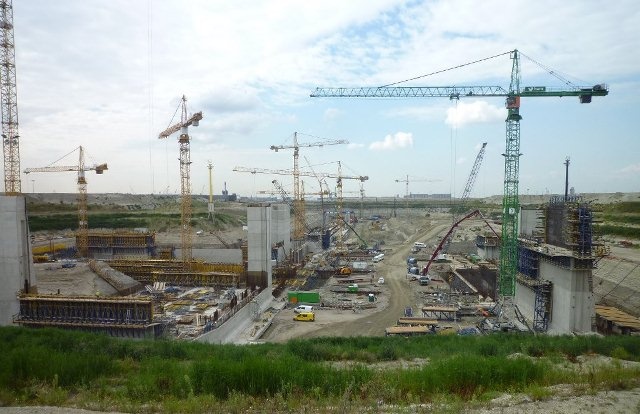 I previously mentioned in Ambassador’s Chat No. 23 that both the Port of Antwerp and the Port of Zeebrugge deepened exchanges with the Port of Nagoya in Japan and the other day a party of 32 people from the Port of Nagoya visited Belgium. The Port of Nagoya has a sister port relationship with the Port of Antwerp for 25 years, so this time, a ceremony to celebrate this anniversary was held. In addition, the Nagoya party invited Belgian port officials to a reception at a venue in Brussels and held a PR event to promote the use of the Port of Nagoya. Just last month, the Port of Nagoya established a partnership relation with the Port of Zeebrugge and I am glad that Japan and Belgium are strengthening their cooperation through the port relations. In terms of total cargo throughput and trade value, the Port of Nagoya is number one in Japan and it has a close relationship with the major ports in the world, playing a central role as export base for automobiles. During the ceremony at the Port of Antwerp, all the people had the opportunity to visit the Deurganck Dock, which is under construction. A giant dock lock, the fourth in the Port of Antwerp, is already taking shape and the deep-water dock of over 500m is expected to be completed beginning of 2016. At its completion, it is therefore expected that the Port of Antwerp will become the No.1 port in Europe. I previously mentioned in Ambassador’s Chat No. 23 that both the Port of Antwerp and the Port of Zeebrugge deepened exchanges with the Port of Nagoya in Japan and the other day a party of 32 people from the Port of Nagoya visited Belgium. The Port of Nagoya has a sister port relationship with the Port of Antwerp for 25 years, so this time, a ceremony to celebrate this anniversary was held. In addition, the Nagoya party invited Belgian port officials to a reception at a venue in Brussels and held a PR event to promote the use of the Port of Nagoya. Just last month, the Port of Nagoya established a partnership relation with the Port of Zeebrugge and I am glad that Japan and Belgium are strengthening their cooperation through the port relations. In terms of total cargo throughput and trade value, the Port of Nagoya is number one in Japan and it has a close relationship with the major ports in the world, playing a central role as export base for automobiles. During the ceremony at the Port of Antwerp, all the people had the opportunity to visit the Deurganck Dock, which is under construction. A giant dock lock, the fourth in the Port of Antwerp, is already taking shape and the deep-water dock of over 500m is expected to be completed beginning of 2016. At its completion, it is therefore expected that the Port of Antwerp will become the No.1 port in Europe.
< Funeral of the Old Lady Next Door >
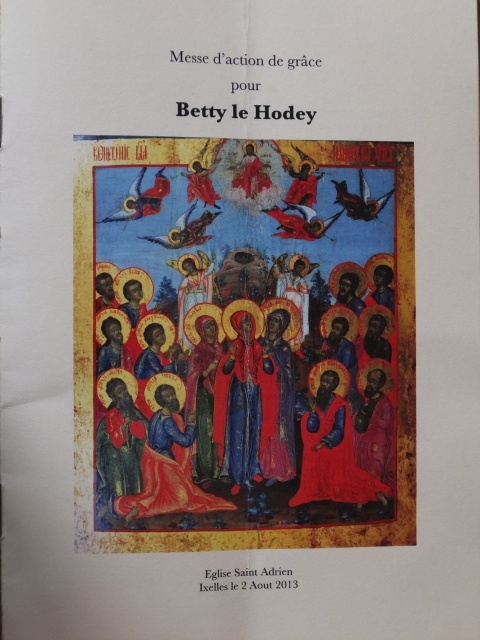 Last month, the old lady who lived next door to the Ambassador’s Residence in Ixelles passed away at the age of 93 and the funeral was held at a church in the neighbourhood. It was a very beautiful funeral attended by nearly 400 relatives, friends and acquaintances. To me, she was not just a neighbour; she was the elder sister of the previous owner of the Ambassador’s Residence and also the mother of the proprietor of a local newspaper company whom I got acquainted with just after my arrival in Brussels. The name of this lady is Mrs Elisabeth le Hodey. She was active as a businesswoman in Belgium after the Second World War and later she became a politician. She strived to improve the social status of women, she established a women’s division in the political party she belonged to and became the first head of this department. She was a devout Catholic, a pioneer in the Women’s Scout Movement and she has played a leading role in the advancement of women in the workplace. After raising 8 children, she lost her husband when she was 46 years old. When she became a window, she became even more active socially and I think that she had a wonderful life. All 89 members of the family, from her 6 children (the eldest son is 68) to grandchildren and great grandchildren attended the funeral. The traditional catholic mass of nearly 2 hours and a half was very impressive to me. The local newspaper published a large “In Memoriam” with a photo that was taken 6 years ago when the then King Albert II made her a baroness for her contribution to the nation. She was one of the women who were at the centre of the generation that rebuilt ravaged Belgium after the Second World War. Last month, the old lady who lived next door to the Ambassador’s Residence in Ixelles passed away at the age of 93 and the funeral was held at a church in the neighbourhood. It was a very beautiful funeral attended by nearly 400 relatives, friends and acquaintances. To me, she was not just a neighbour; she was the elder sister of the previous owner of the Ambassador’s Residence and also the mother of the proprietor of a local newspaper company whom I got acquainted with just after my arrival in Brussels. The name of this lady is Mrs Elisabeth le Hodey. She was active as a businesswoman in Belgium after the Second World War and later she became a politician. She strived to improve the social status of women, she established a women’s division in the political party she belonged to and became the first head of this department. She was a devout Catholic, a pioneer in the Women’s Scout Movement and she has played a leading role in the advancement of women in the workplace. After raising 8 children, she lost her husband when she was 46 years old. When she became a window, she became even more active socially and I think that she had a wonderful life. All 89 members of the family, from her 6 children (the eldest son is 68) to grandchildren and great grandchildren attended the funeral. The traditional catholic mass of nearly 2 hours and a half was very impressive to me. The local newspaper published a large “In Memoriam” with a photo that was taken 6 years ago when the then King Albert II made her a baroness for her contribution to the nation. She was one of the women who were at the centre of the generation that rebuilt ravaged Belgium after the Second World War.
< Car Racing, 36 Years Later >
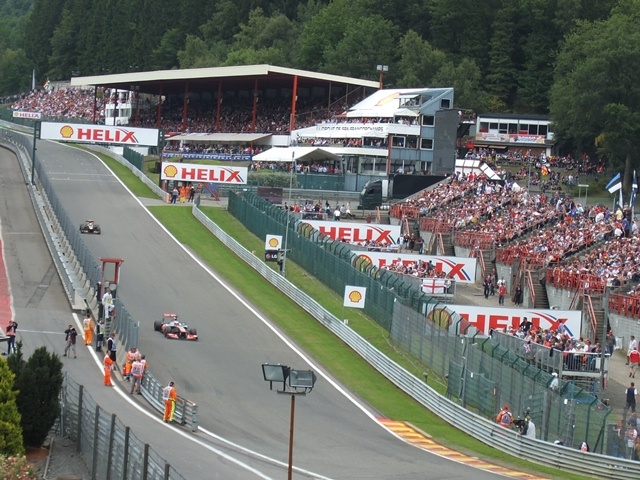 Last Sunday, the World Championship Formula 1 was held at the car race circuit of Spa-Francorchamps, 140km to the southeast of Brussels. Invited by the Walloon Government, I went there to watch the race. I had seen this race before during my previous stay in Belgium, but that was 36 years ago. The race called “the Grand Prix of Belgium” was held for the 46th time this year, but the history of car racing in Belgium goes back a long time. The Belgian Grand Prix seems to have started in 1925 already. It was the time that cars of a Belgian brand were manufactured and even though after World War II the Belgian car production disappeared due to the international competition, the “Belgian Grand Prix” continued to take place every year in all its splendour. In this year’s race no cars from Japanese car manufacturers raced and no Japanese car racers participated either, but several Japanese companies seem to sponsor the event. One lap at the circuit of Spa-Francorchamps is 7km and the race consists of 44 laps (308km). It’s just about the distance between Brussels and Paris. The average speed per round is about 200km/h and the maximum speed is more than 300km/h. The ear deafening roars together with the pressure of the racing cars driving by in front of your eyes in a flash create the full excitement. Watching such races really is very good to get rid of the daily stress… Last Sunday, the World Championship Formula 1 was held at the car race circuit of Spa-Francorchamps, 140km to the southeast of Brussels. Invited by the Walloon Government, I went there to watch the race. I had seen this race before during my previous stay in Belgium, but that was 36 years ago. The race called “the Grand Prix of Belgium” was held for the 46th time this year, but the history of car racing in Belgium goes back a long time. The Belgian Grand Prix seems to have started in 1925 already. It was the time that cars of a Belgian brand were manufactured and even though after World War II the Belgian car production disappeared due to the international competition, the “Belgian Grand Prix” continued to take place every year in all its splendour. In this year’s race no cars from Japanese car manufacturers raced and no Japanese car racers participated either, but several Japanese companies seem to sponsor the event. One lap at the circuit of Spa-Francorchamps is 7km and the race consists of 44 laps (308km). It’s just about the distance between Brussels and Paris. The average speed per round is about 200km/h and the maximum speed is more than 300km/h. The ear deafening roars together with the pressure of the racing cars driving by in front of your eyes in a flash create the full excitement. Watching such races really is very good to get rid of the daily stress…
|